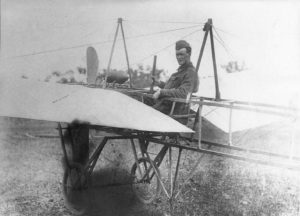1918
Private Jim Hayden poses in the first aircraft to be seen in the Narromine region, a Bleriot - type monoplane which he and his father built at the property 'Acton'. It was underpowered and never made a successful flight, but was displayed statically at the 1917 Narromine show. Jim's son Keith (an airframe fitter at Narromine during the Second World War, and later co-builder of the museum's Wright Flyer replica) recalls seeing parts of the plane, which unfortunately didn't survive.
1920
Sir Ross and Sir Keith Smith and their two mechanics, winners of the first England – Australia air race, are greeted in their Vickers Vimy bomber at Narromine by some 4,000 people. The aircraft was painted with its registration G-EAOU, the phrase ‘God Elp All Of Us’ reflecting the dangers they faced during the epic flight, with few navigational aids or facilities en route
The Australian Government sponsored the race to encourage the development of an air route to Australia , and the winners received the unheard-of sum of 10,000 pounds. The Vimy was the third aircraft to visit Narromine, two aircraft of the Flying Corps having called in the previous year.

1926
Captain (later Sir) Alan Cobham, in a single-engined de Havilland DH.50, makes the first England – Australia return flight. Here he poses at Narromine after landing on the polo ground.
1929
Narromine Aero Club is founded by resolution at a public meeting in the town hall, and over the next decade will host some of the country's most exciting and popular air pageants. Its committee members are:
Back row: R.D. Barnett, G.H.R. Barlow (Vice-president), H. Thrall, G.B. Irvine (Vice-president), H. Bowden Fletcher (Hon Secretary), T.E. Perry (President), R.T. Perry, E.E. MacWilliam. Front row: F. Ballhausen, W. Downey , V.C.S. Hall, W.W. Stockham, H.W. Kierath (Vice-president).
-------
Captain Les Holden, flying his de Havilland DH.61 biplane named Canberra, searches for and finds Charles Kingsford Smith and Charles Ulm’s lost Fokker Southern Cross in northwest Western Australia. Both aircraft visit Narromine en route to Sydney, Holden taking Narromine's first air passengers for the last leg. Shown here at the 1931 Narromine air pageant are Holden and aero club secretary H. Howden Fletcher.
-------
Charles Kingsford Smith, Thomas McWilliams (wireless operator from New Zealand) and Charles Ulm land at Narromine in Southern Cross. It was Smithy’s first visit since a 'barnstorming' tour in 1921.
1930
Twenty-one aircraft perform at Narromine’s first air pageant. One of the first such events in regional New South Wales, it is declared to be the most successful in the country. Here de Havilland DH.60 Moths take off on joyflights, while Les Holden's DH.61 Giant Moth Canberra awaits its turn. Narromine Aero Club will host another three successful pageants during the 1930s.
------
Francis Chichester refuels his DH.60 Gypsy Moth named Mme Elijah at Narromine after his solo England to Australia flight. Decades later Sir Francis, one of the world's great yachtsmen, will be a household name.
1931
Arthur Butler is greeted by a large crowd, following a record nine-day solo England to Australia flight in his tiny Comper Swift. Here he poses with Narromine Aero Club president Tom Perry and secretary Bowden Fletcher. Three years later, Narromine will be a mail hub on Butler's Cootamundra to Charleville leg of the England to Australia airmail service. Post-war, his airline service will be the most extensive in the state.
-------
Newspaper delivery, 1930s style. Milton Kent (left) arrives at Narromine on Easter Sunday for the 1931 air pageant, carrying Sunday Sun newspapers. His aircraft is Westland Widgeon VH-UHU.
-------
Winners of the Silver Cup for model flight duration and mass flight at Narromine’s second air pageant in 1931: Vic Hall and Bern Hawkins of Hall's Narromine Swifts Model Aero Squadron. Hall’s winning entry is an American twin-propeller pusher design.
1932
Air Commodore Sir Charles Kingsford Smith and party arrive at Narromine in Southern Cross and Southern Cross Midget during a 'barnstorming' tour of country towns. A few years later, 'Smithy' would disappear without trace off the coast of Burma.
1933
Imperial Airways’ airliner, the AW.15 Astraea, visits Narromine during an airmail proving flight before returning to England. With a 27-metre wingspan and carrying nine passengers, it is a giant of its day.
1934
New Zealander Jean Batten lands her DH.60 Gipsy Moth at Narromine after a record breaking England to Australia flight. A few months later, competitors in the MacRobertson International Air Race will stop over.
------
1935
Western and Southern Provincial (WASP) Airlines begins a Narromine – Sydney passenger service. Just a couple of years later, WASP will fall victim to the Depression and to a fatal air crash.
1937
A big event for Narromine Aero Club: its first aircraft hangar, still standing to this day, is officially opened.
















